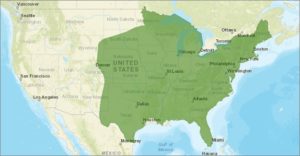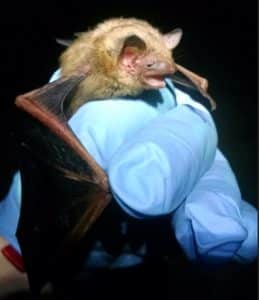How the Tricolored Bat Federal Listing Could Affect Your Project
Another threatened or endangered species listing — this time for the tricolored bat — will likely impact projects across the eastern half of the United States, particularly if they involve clearing trees or work on bridges and culverts.
What is the Proposed Rule Change?


On Sept. 13, 2022, the U.S. Fish and Wildlife Service (USFWS) published a proposed rule listing the tricolored bat (Perimyotis subflavus) as endangered throughout its range. The comment period will end Nov. 14, 2022. The proposed listing follows on the heels of the proposed up-listing of the Northern Long-eared Bat (Myotis septentrionalis) to endangered from threatened. A final rule for the Northern Long-eared Bat is expected in November 2022, and a final rule for the tricolored bat is expected in 2023.
Where Would It Apply?
The tricolored bat has a large range and has been found in 39 states and the District of Columbia. During winter months, the bats hibernate in caves, tree cavities, road culverts and other human structures. During the spring, summer and fall, the bats roost in hardwood and pine forest, Spanish moss and human structures such as barns and beneath porch roofs, bridges and concrete bunkers. The bats forage along forest edges and bodies of water, including streams, ponds and wetlands.
What Would I Need to Do?
The proposed rule states: “At this time, we are unable to identify specific activities that would not be considered to result in a violation of … the [Endangered Species] Act because the tricolored bat occurs in a variety of habitat conditions across its range and it is likely that site-specific conservation measures may be needed for activities that may directly or indirectly affect the species …”


As stated in the proposed rule, the following activities may require coordination and approval from the USFWS:
- Unauthorized collecting, handling, possessing, selling, delivering, carrying, or transporting of the species, including import or export across state lines and international boundaries, except for properly documented antique specimens of these taxa at least 100 years old, as defined by section 10(h)(1) of the Act.
- Disturbance or destruction (or otherwise making unsuitable) of known hibernacula due to commercial or recreational activities during known periods of hibernation.
- Unauthorized destruction or modification of suitable forested habitat (including unauthorized grading, leveling, burning, herbicide spraying, or other destruction or modification of habitat) in ways that kill or injure individuals by significantly impairing the species’ essential breeding, foraging, sheltering, commuting, or other essential life functions.
- Unauthorized removal or destruction of trees and other natural and manmade structures being used as roosts by the tricolored bat that results in take of the species.
- Unauthorized release of biological control agents that attack any life stage of this taxon.
- Unauthorized removal or exclusion from buildings or artificial structures being used as roost sites by the species, resulting in take of the species.
- Within areas used by the species, unauthorized building and operation of wind energy facilities that result in take of the species.
- Unauthorized discharge into sinkholes of chemicals, fill, or other materials that may lead to contamination of known tricolored bat hibernacula.
How Could This Affect My Project?
If your project proposes to clear trees, or remove or impact bridges and culverts, you may need to coordinate with USFWS regarding this species prior to the issuance of any U.S. Army Corps of Engineers Clean Water Act Section 404 permits, federal funding or other approvals with a federal nexus.
For Nationwide Permits, Nationwide Permit General Condition 18 (Endangered Species), paragraph (a) indicates: “No activity is authorized under any NWP which is likely to directly or indirectly jeopardize the continued existence of a threatened or endangered species or a species proposed for such designation, as identified under the Federal Endangered Species Act (ESA), or which will directly or indirectly destroy or adversely modify the critical habitat of such species” (bold emphasis added).
The tricolored bat may make previously non-reporting Nationwide permits require a Pre-Construction Notification (PCN) moving forward. Similar to the Northern Long-eared bat, conservation measures may include time of year restrictions on tree clearing and restrictions on working in and around hibernacula zones.
How We Can Help You
The Freese and Nichols Environmental Science team has experience working with the USFWS on projects that may impact listed bat habitat and is available to assist you in determining the coordination requirements for your project. Please be aware that there is potential to impact project timelines due to additional USFWS coordination, time to prepare, submit and receive approval from the USACE on 404 permit applications, time of year restrictions for construction, or requirements to conduct presence/absence surveys (acoustic or mist net surveys), which can only be conducted from May 15 to August 15.
If you need help navigating these changes, please contact Jason Steele at jason.steele@freese.com or your Freese and Nichols Project Manager.


